Contributory members are able to log private notes and comments about each site
Sites Anne T has logged. View this log as a table or view the most recent logs from everyone
Hier Well (Benrig)
Trip No.158 Entry No.1 Date Added: 2nd Mar 2020
Site Type: Holy Well or Sacred Spring
Country: Scotland (Scottish Borders)
Visited: Yes on 27th Feb 2020. My rating: Condition 2 Ambience 4 Access 4
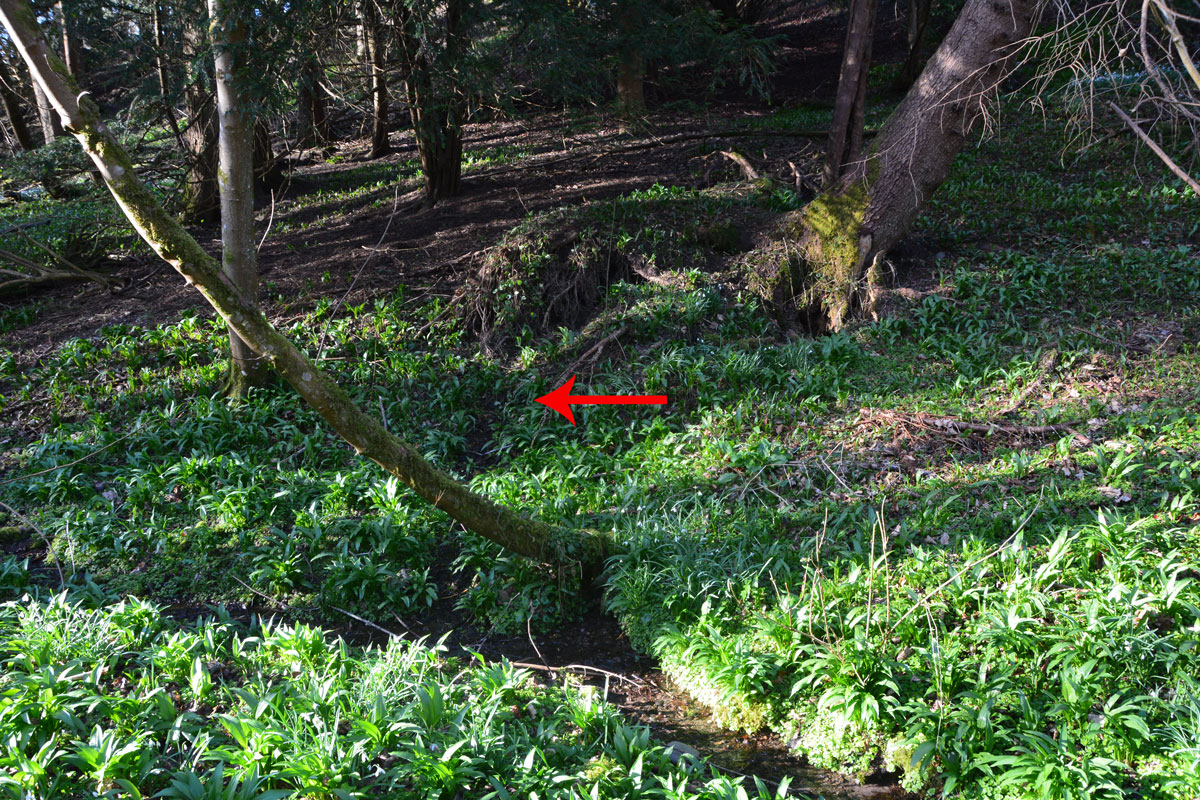
Hier Well (Benrig) submitted by Anne T on 2nd Mar 2020. The red arrow shows where the spring which feeds Hier Well emerges from the base of a wooded slope, just underneath the roots of an uprooted tree. There is a fair trickle of water emerging from the bank.
(View photo, vote or add a comment)
Log Text: Hier Well, Benrigg/Maxton: We first tried to get here by following St Cuthbert’s Way from the cemetery/old chapel ruins at Benrig, but there was a steep drop down to the river below on one side, and the path was muddy and slippery. Andrew said a set of steps down to the Crystal Well were too steep for me to cope with (although later, from below, they looked OK), so we tried again from the church by Glebe House (more details below).
We found the source of the spring, as described at the foot of a wooded slope, but no sign of the structure photographed by Cope, even though we walked alongside the stream to the wooden bridge looking.
A beautiful woodland location, and very peaceful. On the far side of the ford, another well (Well-brae) was marked on the OS map, but after heavy rain in the area, the ford was too deep to cross at this point, without wellies, which we didn't have.
Crystal Well (Benrig)
Trip No.158 Entry No.2 Date Added: 2nd Mar 2020
Site Type: Holy Well or Sacred Spring
Country: Scotland (Scottish Borders)
Visited: Yes on 27th Feb 2020. My rating: Condition 3 Ambience 4 Access 4

Crystal Well (Benrig) submitted by Anne T on 2nd Mar 2020. The spring/well grotto from its southern side. It is a very attractive feature. Whilst the spring must have older origins, the surrounding structure is 19th century.
(View photo, vote or add a comment)
Log Text: Crystal Well and Mule Gang, Benrig: We retraced our steps along the road from Hier Well almost to the wooden bridge, then turned north and followed a track through the woodland between a bank on our left hand side and the River Tweed on our right.
What looked like lime kilns came into view, although this turned out to be the very interesting Mule Gang and pump house. The gate into the Crystal Well was open, and I straddled the small stream of water emerging from it to photograph the well basin and chamber behind. The water appeared to gush straight out of gravel at the back of the well chamber.
A really beautiful location, and I’m surprised there weren’t more walkers and visitors around here.
Caulks Well (Selkirk)
Trip No.158 Entry No.3 Date Added: 5th Mar 2020
Site Type: Holy Well or Sacred Spring
Country: Scotland (Scottish Borders)
Visited: Yes on 27th Feb 2020. My rating: Condition 3 Ambience 4 Access 4
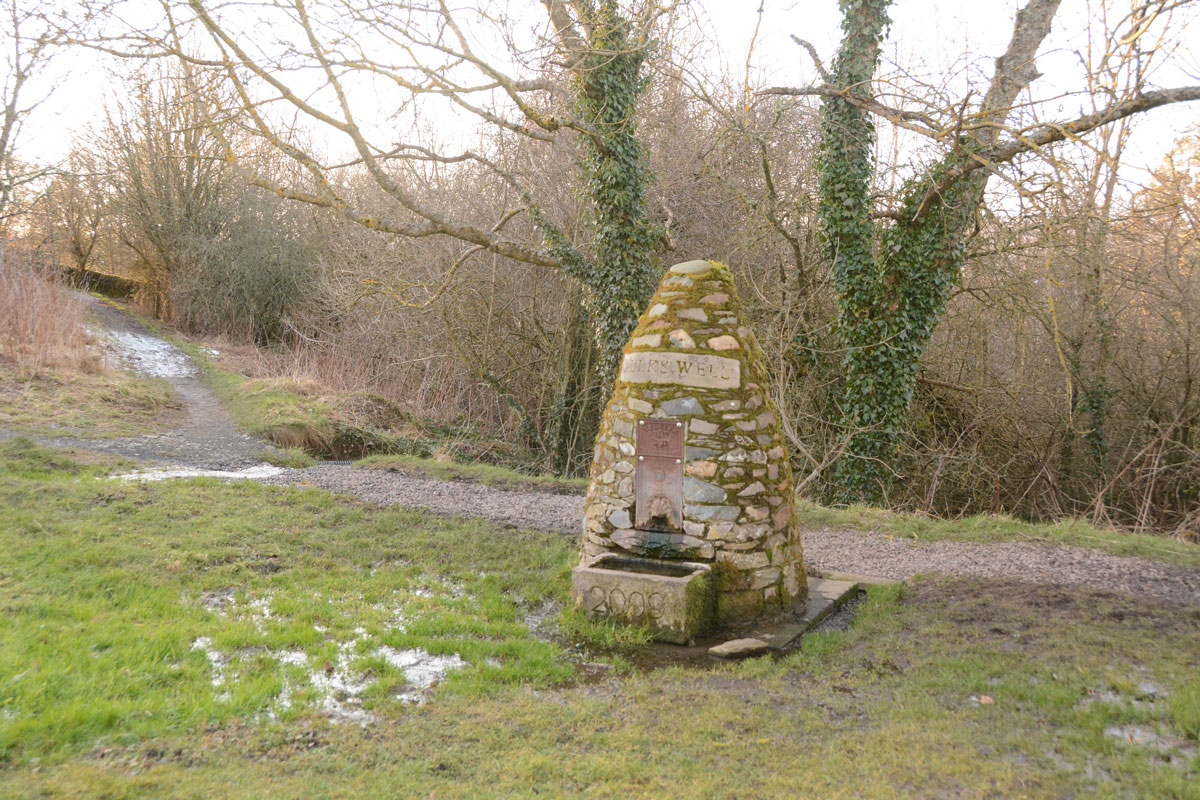
Caulks Well (Selkirk) submitted by Anne T on 5th Mar 2020. Standing just to the east of the well, at the bottom of one of the mounds on the golf course. There was so much water at the time of our visit that the whole area around the well was almost ankle deep in water. It was not obvious from standing by the well how the water arrives at this location, but standing where we parked at NT 47845 27908, just across the A699, there are a series of hills behind from which the water must run down to the well.
(View photo, vote or add a comment)
Log Text: Caulks Well, Selkirk Hill: No mention on Canmore.
We parked in a small layby at NT 47734 27869, which had been largely used for dumping road repair materials, then crossed to the northern side of the A699 and walked up (North East) to the Borders Abbey Way, and followed the track some 150 metres (part of the path were icy) to the well.
Right at the edge of the Golf Course, there is such a plentiful stream of water that there are three sources of the spring in the same small area: (1) at the base of the signpost; (2) at the well house itself, and (3) in a pool which emerges just to the south of the well house. The water tumbles down to the stream below.
Source: https://blackbob.org.uk/pdf/Trail1-SelkirkHill.pdf
Turn left, and follow the track until the Borders Abbeys Way signpost (12), turn left again, to follow the Way back to the A699. You pass the Hill Shelter (13), and a picnic bench (14), then Caulks Well (15), a drinking fountain. The water from here is so good to drink that a former Provost (who shall remain nameless!) used to bring a bottle to take water from it to have with his whisky; and an Italian woman, who met and married a soldier from Selkirk at the end of WW2, coming to live in the town, would drink nothing else."
Tamlane's Well (Carterhaugh)
Trip No.158 Entry No.4 Date Added: 5th Mar 2020
Site Type: Holy Well or Sacred Spring
Country: Scotland (Scottish Borders)
Visited: Yes on 27th Feb 2020. My rating: Condition 3 Ambience 4 Access 5
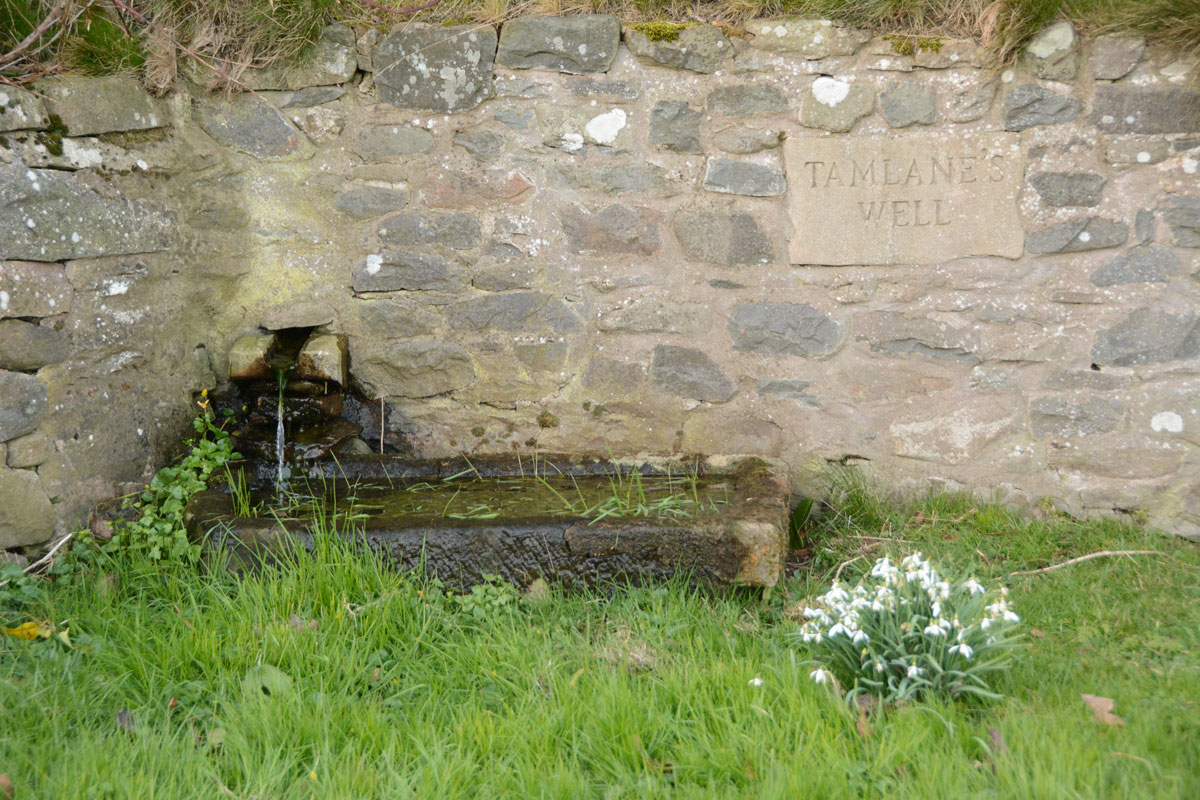
Tamlane's Well (Carterhaugh) submitted by Anne T on 5th Mar 2020. Getting closer to the well trough. The water must drain from the stone trough into a modern drain, about a metre in front of the current structure, then through a pipe under the road into a small stream/field drain in the field to the south.
(View photo, vote or add a comment)
Log Text: Tamlane's Well, Carterhaugh: A delightful spot, next to the single track B7039, parts of which aren’t terribly well defined (and we ended up in a very large farmyard, having taken a wrong turn!). The well is located right by the road, in a small grassy area just to the south of a large set of the Carterhaugh farm buildings/barns, although separated it by a dry stone wall. Whilst the original well was some 2.5m behind the wall, and is now filled in, the well is now presented in a nice way, presumably to allow visitors to access the well, which was really good of the farmers.
There was a steady flow of water into a trough which then drained into a modern manhole about a metre to the south of the well trough.
St Oswald's Church (Lythe)
Trip No.159 Entry No.1 Date Added: 8th Mar 2020
Site Type: Ancient Cross
Country: England (Yorkshire (North))
Visited: Yes on 4th Mar 2020. My rating: Condition 3 Ambience 5 Access 4
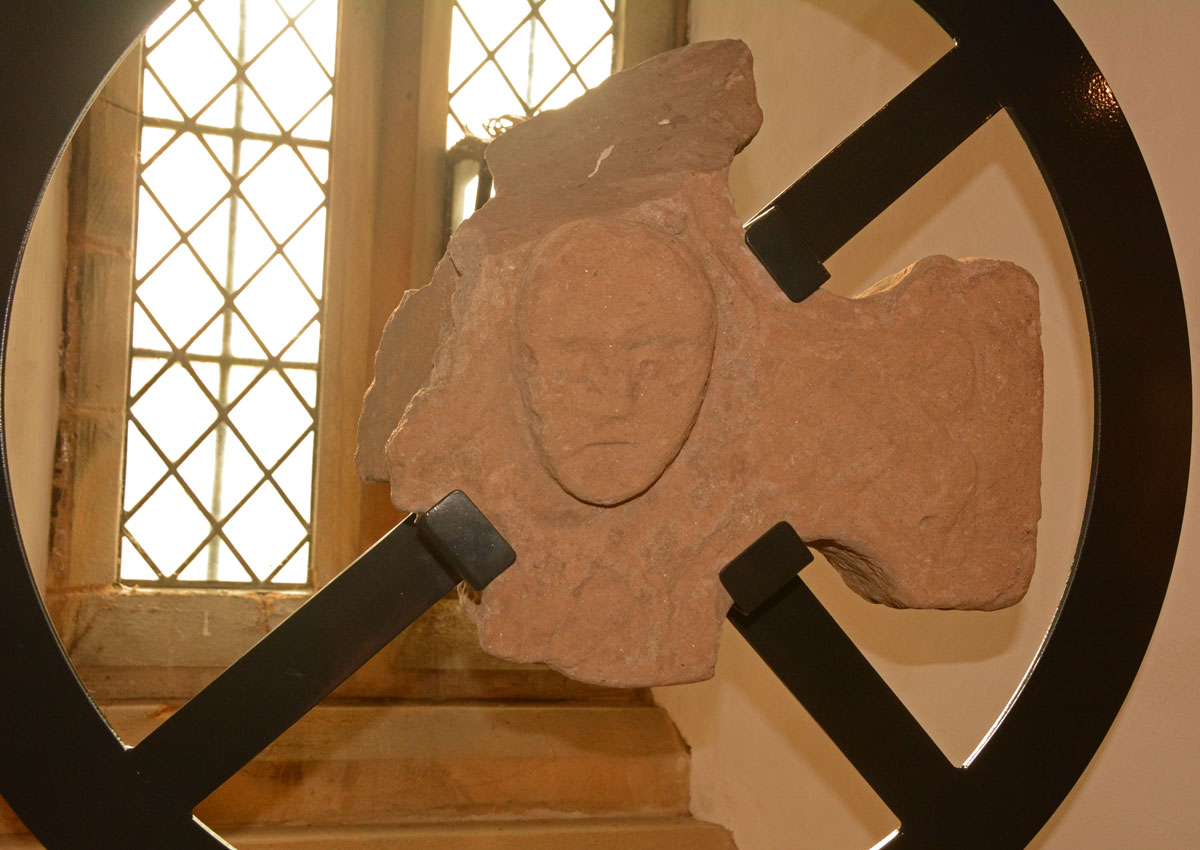
St Oswald's Church (Lythe) submitted by Anne T on 8th Mar 2020. The cross head fragment with its human head in the centre. As displayed in the south window at the west end of the nave.
(View photo, vote or add a comment)
Log Text: St Oswald's Church, Lythe: Our first stop of the day, and one I was very much looking forward to. Parking is available in the small lane to the west of the church (just off the A174 Lythe Lane). A notice put up by the farmer asked cars to park on one side of the lane only, so they had continuous access to their fields behind the church.
I was concerned about if I'd be able to make it down the 'windy stone steps' to the basement, where many of the Anglo Scandinavian and medieval stones were displayed. I needn't have worried, as the steps were modern, and whilst there was no hand-rail, they were easy enough to descend (although I did manage to dislodge small chunks of stone from the south wall as I descended).
We spent an hour and a half here, then needed to move on. I would have liked to have spent another hour (at least) here, with the notes printed from the Corpus of Anglo Saxon Stone Sculpture, and better lighting to take better photos of the stones in the basement.
Wades Stone (North)
Trip No.159 Entry No.2 Date Added: 6th Mar 2020
Site Type: Standing Stone (Menhir)
Country: England (Yorkshire (North))
Visited: Yes on 4th Mar 2020. My rating: Condition 3 Ambience 3 Access 4

Wades Stone (North) submitted by DavidRaven on 10th May 2005. Showing the large groove on the northern Wade's Stone.
(View photo, vote or add a comment)
Log Text: Wade's Standing Stone (North), Brockrigg: We must have completely forgotten we'd visited this stone before, as neither of us recognised either the road or the lane leading up to the stone. However, we walked up the lane towards the farm, and followed the tractor tyre tracks up to the stone to avoid damaging the seedling plants in the field (the field was planted with small cabbage plants which had recently sprouted). The Pastscape entry says this was originally one of two stones, and we tried to look for possible signs of where the second stone may have stood, but could see nothing.
The deep erosion on the stone was interesting. I looked for the graffiti but only spotted the letters JS on its southern face. The OS map shows this stone to be placed near the Parish boundary line.
Wades Stone (South)
Trip No.159 Entry No.3 Date Added: 6th Mar 2020
Site Type: Standing Stone (Menhir)
Country: England (Yorkshire (North))
Visited: Saw from a distance on 4th Mar 2020
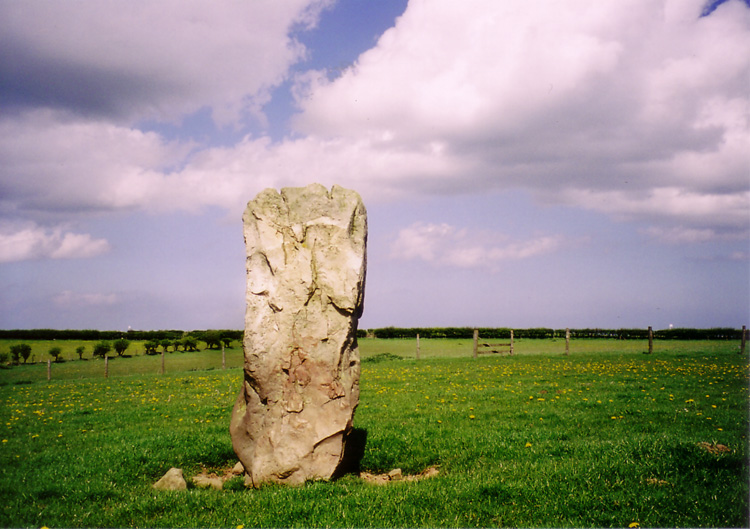
Wades Stone (South) submitted by DavidRaven on 13th May 2005. The southern Wade's Stone, looking north.
(View photo, vote or add a comment)
Log Text: Wades Stone (South): As per our last visit, we were unable to find anyone to ask at the now Council Depot (not the Outdoor Centre as marked on the map), and couldn't see any field access into the field containing the stone, either from the corner of East Barnby Lane and the A171 (at NZ 82845 13203), or off the main road. As there were other sites we were really keen to see, we drove on without making an attempt to see this stone. Shame.
St Hilda's Well
Trip No.159 Entry No.4 Date Added: 6th Mar 2020
Site Type: Holy Well or Sacred Spring
Country: England (Yorkshire (North))
Visited: Yes on 4th Mar 2020. My rating: Condition 3 Ambience 4 Access 4
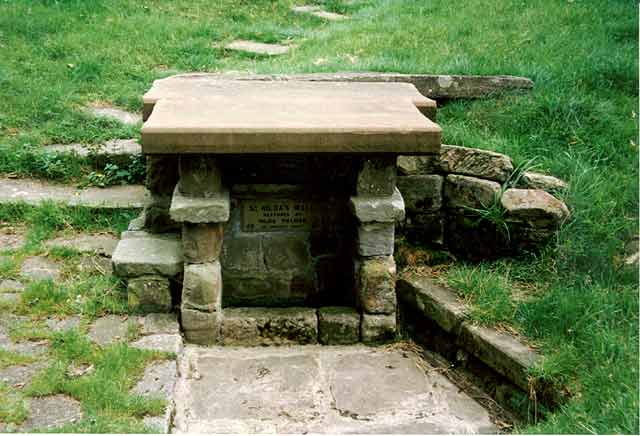
St Hilda's Well submitted by kelpie on 21st Feb 2004. NZ 7911 1706
This well which lies in the churchyard at Hinderwell is said to have curative properties for the eyes.
Restored in 1912.
(View photo, vote or add a comment)
Log Text: St Hilda's Well, Hinderwell: We parked just past the church in a small layby next to the A174 Hinderwell Lane, at NZ 79018 17137, as the road running past the church was very narrow. Having driven past the church to find somewhere to park, we came across a gated access with a plaque saying ‘St Hilda’s Well’, so parked and walked back to it.
The gate led onto a grassy path which led towards the well at the northern side of the church. As we walked up the path, we disturbed a very large parliament of rooks who had settled in the trees nearby; Andrew commented it was like walking into Hitchcock's 'The Birds', especially with the church dark and looming above us, with dark grey skies beyond.
Reaching the well, the well basin had clear water in it, although the large pool in front was dry and full of leaves. However, there was a steady stream of water which flowed downhill from the church, having presumably been piped away underground a short distance.
There appeared to be the top of an Anglo Saxon window head piled on top of stones at one side of the well; at the other, there was part of a very small stone coffin.
Inside the church there was also a leaflet about the church and the well. This is what is says about the well:
“We learn from Bede that S Hilda was born in 614. She was the second daughter of Hereric, great nephew of King Edwin of Northumbria. Her elder sister, Hereswith, married the King of East Anglia. Hilda was baptised in 627, along with King Edwin and some of his nobles and courtiers. In 647, Hilda decides to live as a nun in Northumbria. Aidan appointed Hilda second Abbess of Hartlepool. In 657 Hilda became the founding abbess of a new monastery at Whitby (then known as Streonshalh).
According to legend, St Hilda was asked to intercede in a drought whilst travelling throughout the parish. Her prayers were answered and the spring which appeared has continued to bubble from the hillside in the grounds of St Hilda’s Church, Hinderwell to this day. The waters were said to have healing properties particularly for eye diseases, and the Well became a place of pilgrimage during the Middle Ages. The Well is the only Scheduled Ancient Monument in the parish and was renovated in the early 1900s by the Palmer family.
St Hilda is also said to be responsible for the ammonites or fossilised mollusca shells often found along this coastal stretch, as they resembled curled-up headless snakes. Again according to legend, she had prayed for all the snakes of the neighbourhood to lose their heads and turn to stone. For this reason ammonites are known locally as St Hilda’s Snakes. 19th November is St Hilda’s Day.
Hilda suffered from fever for the last six years of her life, but she continued to work until her death in 680, aged sixty-six. In her last year, she set up another monastery, fourteen miles from Whitby, at Hackness, where there is also a St. Hilda Spring. The church now standing in the village of Hinderwell (see below), is dedicated to St Hilda, but the Holy Well in the churchyard has much earlier origins and almost certainly gave its name to the village. A service to celebrate the Well is held on the first Sunday of July."
Hinderwell Cross Head
Trip No.159 Entry No.5 Date Added: 7th Mar 2020
Site Type: Ancient Cross
Country: England (Yorkshire (North))
Visited: Yes on 4th Mar 2020. My rating: Condition 2 Ambience 3 Access 4
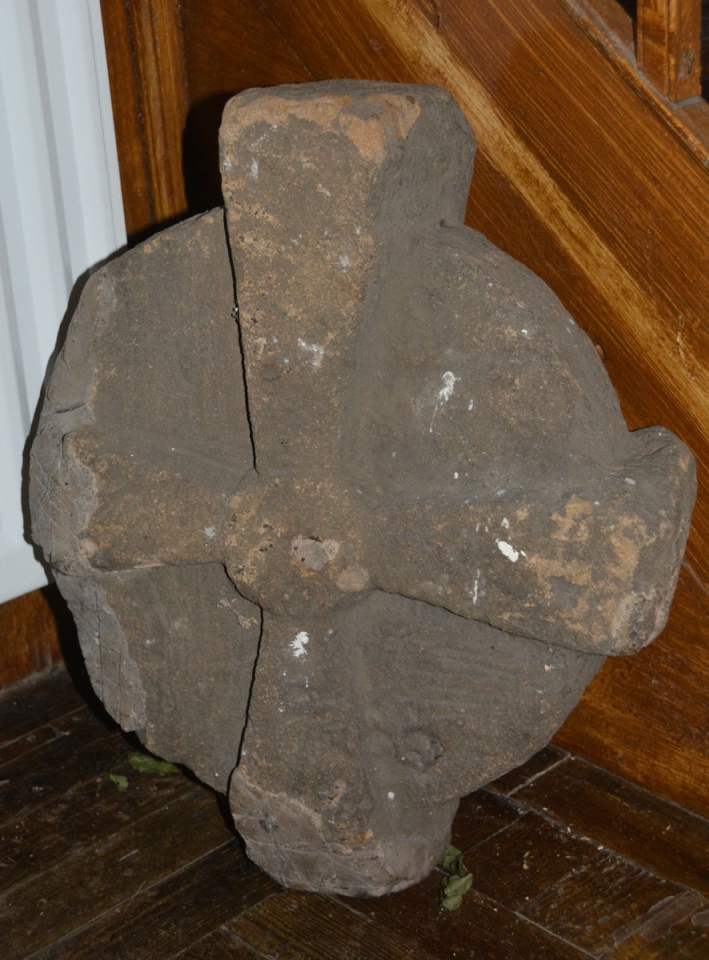
Hinderwell Cross Head submitted by Anne T on 7th Mar 2020. We very carefully moved the flower arrangement next to the stone to photograph it. The mastic repair to the lower arm can be clearly seen on this side.
(View photo, vote or add a comment)
Log Text: The Hinderwell Cross Head, St Hilda's Church: Whilst the church itself is well kept and nicely presented, this cross head is tucked away in the foyer of the church, at the bottom of the stairwell leading to the gallery/organ.
After photographing the well, we wandered up to the church, finding it open. Just inside, to the left hand side of the lobby, next to the stairs ascending to the gallery, was a cross head, which I photographed. Inside was a leaflet describing local heritage, and I found a short section about both Lythe and the Hinderwell Cross in there.
Just outside the south door, about 3m to the south west, is part of either a cross base or a column, which I also photographed.
Guy Points, in his Gazetteer of Anglo Saxon and Viking Sites: Yorkshire, only mentions the well (pages 161/162).
Easington Cross
Trip No.159 Entry No.6 Date Added: 7th Mar 2020
Site Type: Ancient Cross
Country: England (Yorkshire (North))
Visited: Yes on 4th Mar 2020. My rating: Condition 3 Ambience 3 Access 4
Easington Cross submitted by johndhunter on 31st Jan 2020. Easington Cross at NZ 74427 18004 – Closer view, the possible shaft next to the broken medieval base looks like it has a sword carved on it, January 2012.
(View photo, vote or add a comment)
Log Text: Easington Cross Base: The cross base is recorded as HE 1011970 and as Pastscape 1583425. Pastscape 29031 tells us there are "nine Saxon stone fragments [in the basement] at (the) Church of All Saints", although my attempts to contact the vicar by telephone and email have not been successful. I did speak to a gentleman who I thought was the church warden, but he told me "he no longer holds an official position within the church".
As we were passing through the village anyway, we stopped to see the cross base, although the church was well and truly locked.
As well as the cross base, there is also a sundial towards the western end of the churchyard, and a drinking fountain at NZ 74521 18036, at the side of the main Loftus-Whitby Road.
Three Crosses Well (Boulby)
Trip No.159 Entry No.7 Date Added: 7th Mar 2020
Site Type: Holy Well or Sacred Spring
Country: England (Yorkshire (North))
Visited: Yes on 4th Mar 2020. My rating: Condition 3 Ambience 4 Access 4
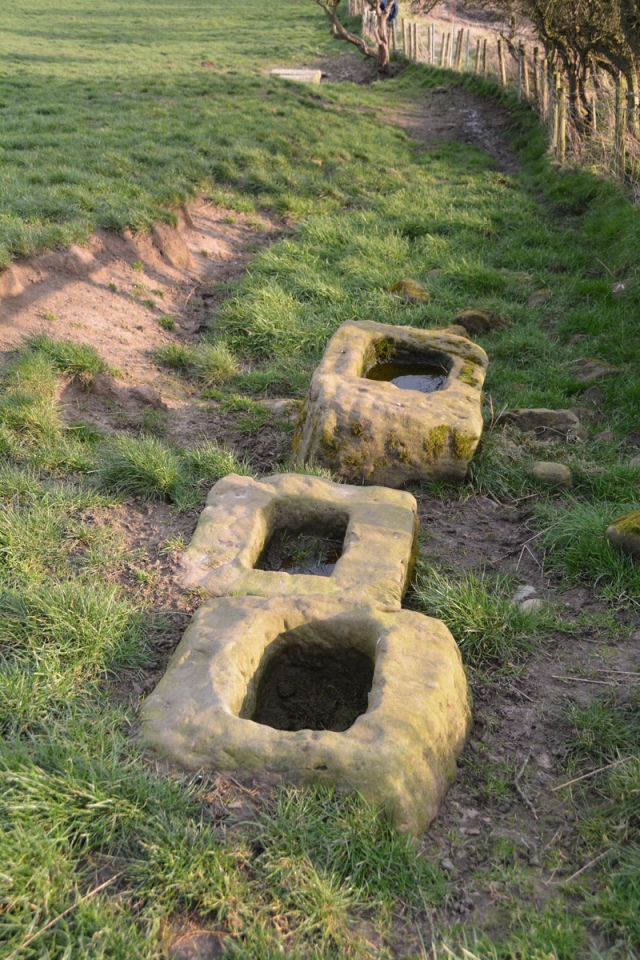
Three Crosses Well (Boulby) submitted by Anne T on 7th Mar 2020. The three cross bases, with the top of the well house just visible down slope.
(View photo, vote or add a comment)
Log Text: Three Crosses Well, Boulby: Parked outside the holiday cottages (there was a large layby just down the road). Originally followed the footpath sign, which took us down a steep bank, but Andrew found a farm track a little further along the south side of the A174, laid through a new area planted with saplings. Despite looking for someone to ask permission from at the farm and the holiday cottages, we were unable to find anyone, so were very carful to stick to the footpath/track.
At the end of this track, three cross bases came into view, and we peered over the fence line to see the well. The well house itself is a little down slope from the cross bases. We were curious as to the connection between the cross bases and the well.
The view of the sea from the cross bases is hidden by a natural small hill/mound. This is a magnificent site, despite the proximity to the potash mine.
Easington Cross
Trip No.160 Entry No.2 Date Added: 20th Mar 2020
Site Type: Ancient Cross
Country: England (Yorkshire (North))
Visited: Yes on 19th Mar 2020. My rating: Condition 3 Ambience 3 Access 4
Easington Cross submitted by johndhunter on 31st Jan 2020. Easington Cross at NZ 74427 18004 – Closer view, the possible shaft next to the broken medieval base looks like it has a sword carved on it, January 2012.
(View photo, vote or add a comment)
Log Text: Easington Hogbacks and A-S stone fragments: We had already seen the cross base in the churchyard, but arranged with the Reverend Danny Walker to revisit when the church was open. He was there with a very knowledgeable churchwarden (with his two wonderful dogs) to move some furniture around so they could leave the church open for parishioners and visitors at this current time of crisis.
The churchwarden took us into the tower to see a Norman arch that had been rebuilt on the first floor to preserve it. He also showed us St Hilda’s Cross base, and what he said was part of the cross shaft, but I said I thought was a medieval cross-slab as it clearly had a sword on it in the sunlight.
The vicar had cleared the steps to the basement boiler room, where we were allowed to move the old screens and debris to find any pieces we could. We found all but one of the pieces listed on the Corpus (the other may have been under debris, but with dead birds in the corner, we were reluctant to explore this part of the room). A real treat, and thanks to the vicar for opening the church up for us.
Lady Well (Kirklington)
Trip No.161 Entry No.1 Date Added: 7th Jun 2021
Site Type: Holy Well or Sacred Spring
Country: England (Yorkshire (North))
Visited: Yes on 31st May 2021. My rating: Condition 3 Ambience 4 Access 4
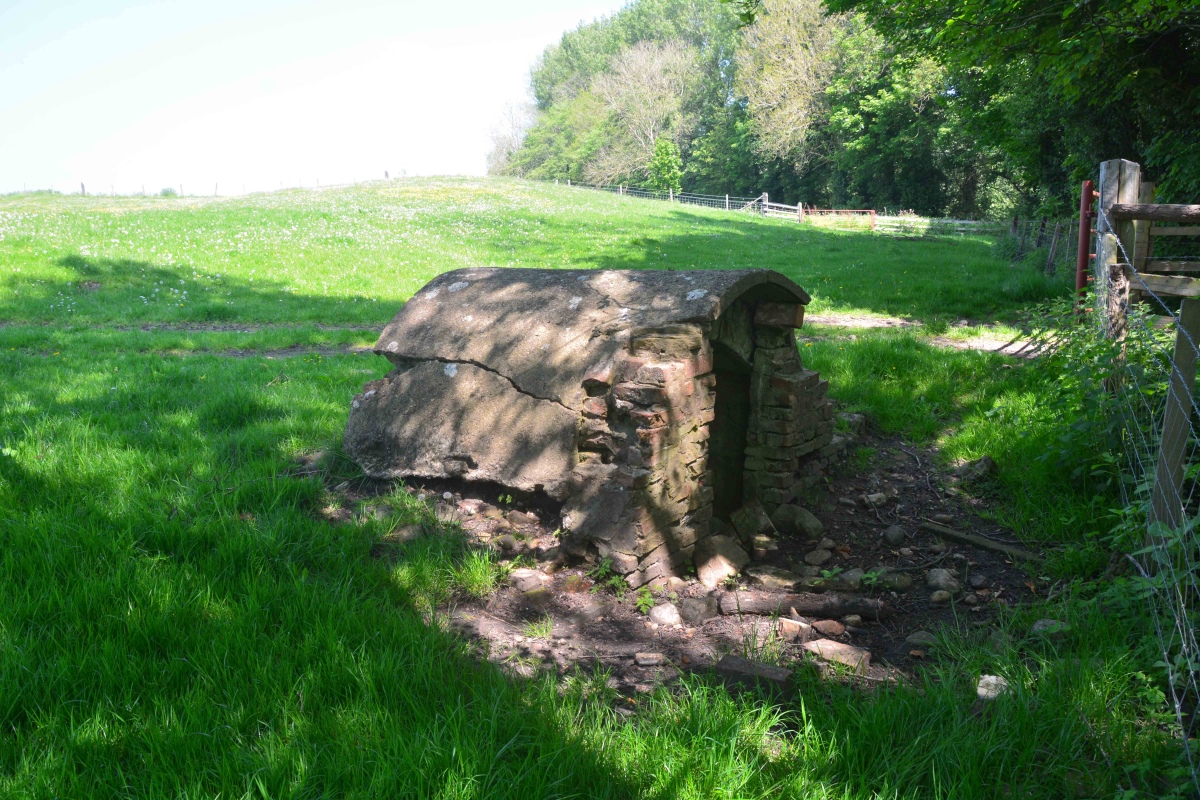
Lady Well (Kirklington) submitted by Anne T on 6th Jun 2021. View of Lady Well, Kirklington, from just to its western side. The remains of building platforms from the now deserted medieval village of Yarnwick lie above, and to the left of, the well house.
(View photo, vote or add a comment)
Log Text: Lady Well (Kirklington): our first site, in our first day out for 15 months. What a delightful location, although a shame the well house itself is crumbling and full of rubbish.
With the site of the deserted medieval village of Yarnwick in the same field, and to the north of, the well, it was a delight to be back in the countryside again
I stopped to photograph a second, now capped well, presumably the well supplying the farmhouse, at SE 31634 81303.
St Michael's Church (Well)
Trip No.161 Entry No.2 Date Added: 7th Jun 2021
Site Type: Ancient Cross
Country: England (Yorkshire (North))
Visited: Yes on 31st May 2021. My rating: Condition 3 Ambience 4 Access 4
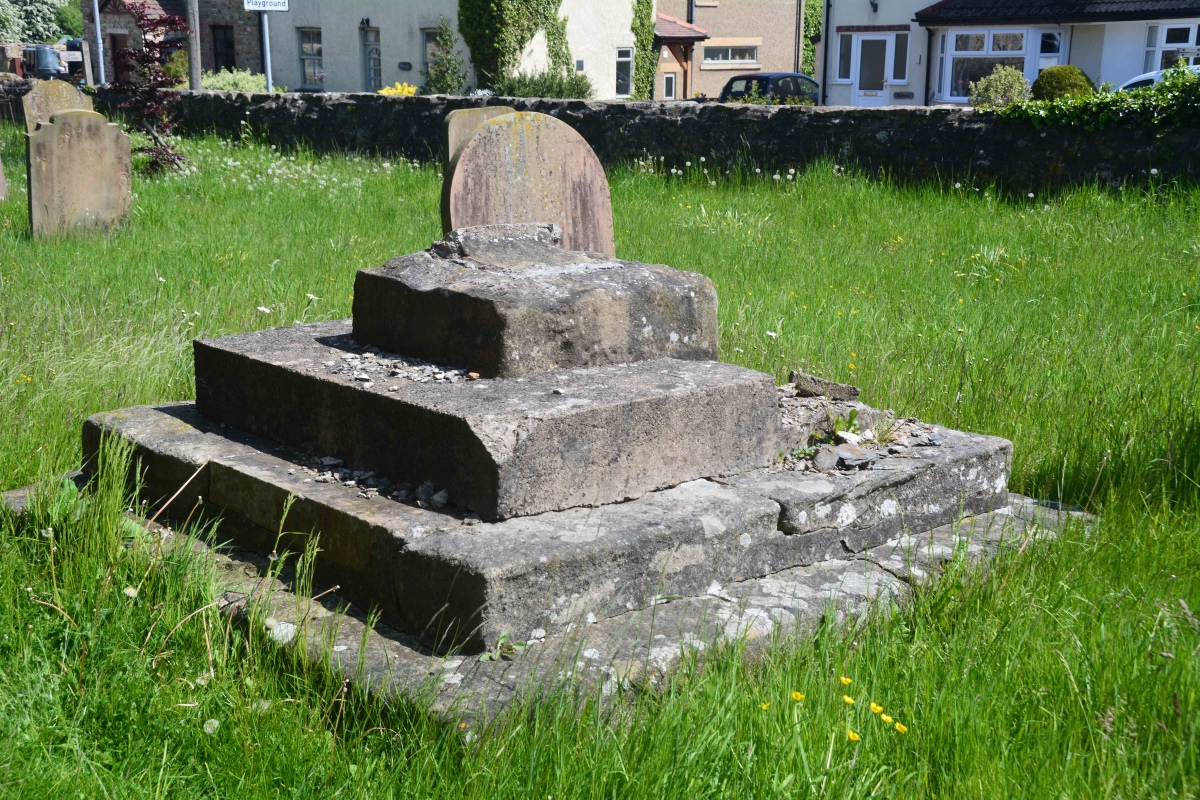
St Michael's Church (Well) submitted by Anne T on 7th Jun 2021. The cross base from the external south wall of the nave, looking eastwards down Church Street.
(View photo, vote or add a comment)
Log Text: Cross Base, St Michael's Church, Well: Our second stop of the day, arriving in glorious sunshine. Parking is available immediately outside the lych gate, and along Church Street. The HE record led me expect a 3m tall cross shaft, but this had been broken off, with no sign of it lying anywhere close to the cross base.
Understandably, the church remains locked to visitors due to pandemic restrictions, but we wandered round the outside of the church, photographing the few medieval grave slabs built into the fabric of the old building, and the sundial (very, very worn) over the south porch door.
The lower part of the tower is clearly early - 12th century in date at the bottom, the western side containing a very old wooden door which looks like it leads up to the belfry. I would be very interested to go back, as the church contains part of a Roman mosaic found locally, along with some interesting tombs and effigies
St Michael's Well (Well)
Trip No.161 Entry No.3 Date Added: 7th Jun 2021
Site Type: Holy Well or Sacred Spring
Country: England (Yorkshire (North))
Visited: Yes on 31st May 2021. My rating: Condition 3 Ambience 4 Access 5
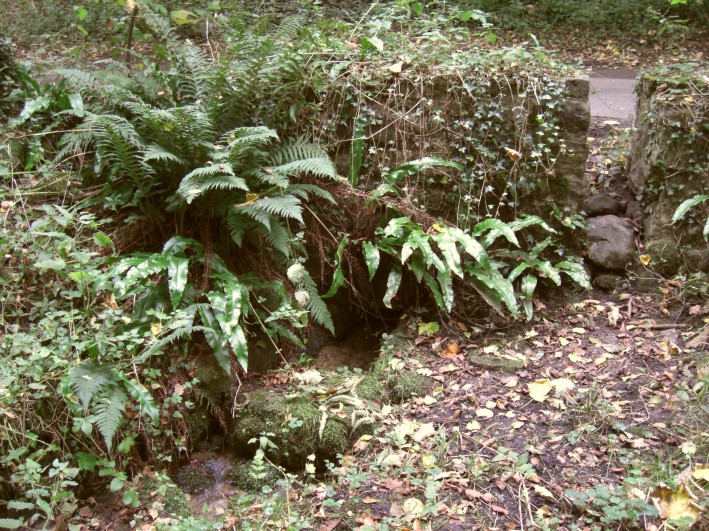
St Michael's Well (Well) submitted by jamesrattue on 20th Oct 2008. St Michael's Well, Well, North Yorkshire, photographed October 2008.
(View photo, vote or add a comment)
Log Text: St Michael's Well, Well: Our third stop of the day, driving west out of Well village, up a shady, pretty single track road with trees on either side. With little/no traffic on this road, we pulled into the passing place/small layby immediately opposite the well. At first, I didn't think anything was here, but behind the stone wall and wooden fence to the northern side of the road, there was the very distinct sound of running water.
Behind the small stone wall are some steps which lead down to the well itself, through which copious amounts of very clear water are running. This water then leads into a small stream which runs into Well Beck.
We didn't realise until later that the actual source of the water was from the southern side of the road, which also has a stone wall structure, fronted by what is now a muddy patch (once the well pool?). The water looks as if it originally emerged from by a large tree now growing in the wall. This area of ground has been heavily churned by cattle and the small gap/stile in the wall at this point has been wired off.
A very lovely spot, well worth the visit.
Berry Well
Trip No.161 Entry No.4 Date Added: 8th Jun 2021
Site Type: Holy Well or Sacred Spring
Country: England (Yorkshire (West))
Visited: Yes on 31st May 2021. My rating: Condition 3

Berry Well submitted by jamesrattue on 23rd Oct 2008. Berry Well at Swinton, photographed 18th October 2008.
(View photo, vote or add a comment)
Log Text: Berry Well, Swinton Park Hotel: After St Michael's Well in Well, we stopped off in Masham for refreshments, stopping to photograph the water troughs/Renton Well in Masham before setting off to find Berry Well.
We parked at SE 21443 79735, just to the south of the hotel lodge gates. As I stepped out of the car, I immediately noticed the trough.
The area of grass verge up to the well from the hotel gates has been recently strimmed. The sound of running water can be clearly heard. The well basin is well under the current ground level, and largely hidden by the weed trimmings. The water is piped under the road, although there is no indication that we could find of where the water goes to.
There is a pond on the other side of the wall, which feeds the well. There is a small, lively, very clear stream which wends its way down a very gentle slope in the grounds of the Swinton Park Hotel. (The gates of the hotel were open, so we popped in and followed the wall along).
There is another section of trough on the hotel side of the wall.
Skew Skell Well
Trip No.161 Entry No.5 Date Added: 8th Jun 2021
Site Type: Holy Well or Sacred Spring
Country: England (Yorkshire (North))
Visited: Yes on 31st May 2021. My rating: Condition 2 Access 4
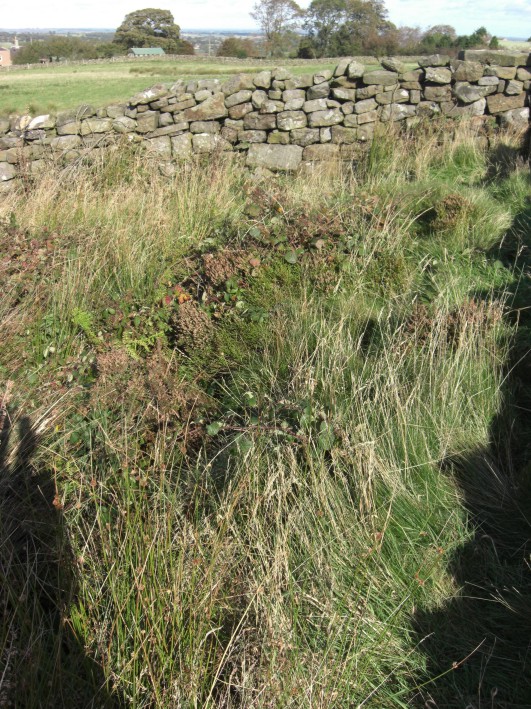
Skew Skell Well submitted by jamesrattue on 23rd Oct 2008. Skew Skell Well at Ilton, photographed 16th October 2008.
(View photo, vote or add a comment)
Log Text: Skew Skell Well, Ilton: We parked at SE 18823 78010, and walked NW down the slope with GPS in hand to find this well. It is in a small, rectangular area (to our right hand side) defined by a the stone walls forming an enclosure open at its south-western side, presumably to accommodate, and allow access to the well and a spring.
The ground was very heavily covered with foliage and nettles. The sound of running water could be clearly heard. Skew Skell Well could be made out by standing in the NE of the enclosure (there was a deep dip, filled with water). The spring appeared to be on the NW edge of the enclosure, with water now appearing to rise just over the stone wall, in the adjacent field. This flow of water could be followed downhill by a line of reeds.
On the opposite side of the road, there was another large pool of water. Other springs rise in the area. Water from Skew Skell Well must be piped under the road and run down the drainage ditch at the other side of the lane.
Billey Keld
Trip No.161 Entry No.6 Date Added: 8th Jun 2021
Site Type: Holy Well or Sacred Spring
Country: England (Yorkshire (West))
Visited: Yes on 31st May 2021. My rating: Condition 3 Ambience 3 Access 4
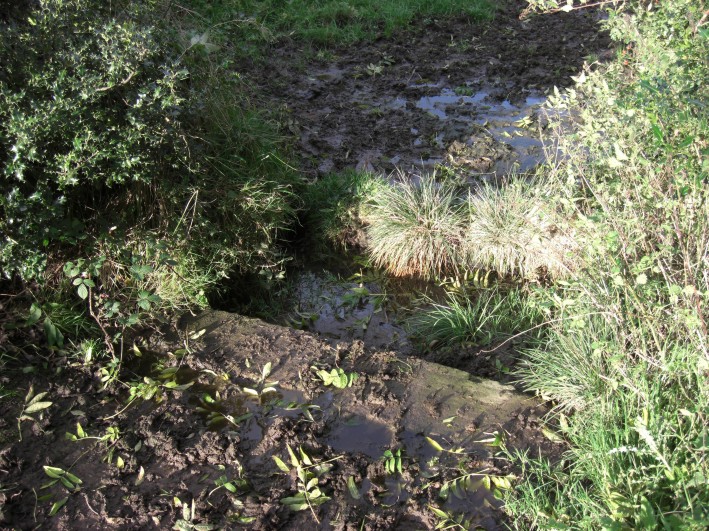
Billey Keld submitted by jamesrattue on 23rd Oct 2008. Billey Keld at Grewelthorpe, photographed 15th October 2008.
(View photo, vote or add a comment)
Log Text: Billey Keld Well, Grewelthorpe: With some very lively bullocks in the field, we decided not to venture into the field through the gate to look at well. However, we managed to see some of the structure from the roadside.
A local lady walking her dog stopped to talk to us and say she remembers visiting the well to collect water when she was a child.
Ings Well (Mickley)
Trip No.161 Entry No.7 Date Added: 9th Jun 2021
Site Type: Holy Well or Sacred Spring
Country: England (Yorkshire (West))
Visited: Yes on 31st May 2021. My rating: Condition 3 Ambience 4 Access 4
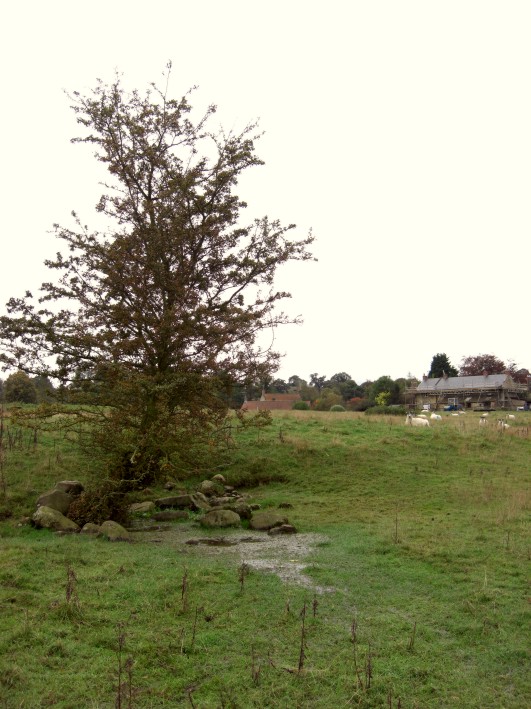
Ings Well (Mickley) submitted by jamesrattue on 23rd Oct 2008. Ings Well at Mickley, photographed 15th October 2008.
(View photo, vote or add a comment)
Log Text: Ings Well & Spring, Mickley (North Yorkshire): Our last stop of the day, and what a pretty site, with an easy walk down the Ripon Rowel Way from Mickley village. Note: there was a very rickety stile to cross as you entered the field at SE 25833 77052 (the top step was like a see-saw, although climbing the gate might have been easier!).
Sited under a lone hawthorn tree to the left hand side of the footpath, water flows freely out of the ground and spreads out into the field.
At SE 25954 77141 a large wooden post marks the location of a spring, the waters of which appear to flow south-east to north-west along a drainage channel. I wanted to investigate further, and also walk to another well (marked 'W' on the HE map search) at SE 26090 77149, but the field was far too wet and boggy and I was sinking up to my ankles in water. So wish I'd taken a pair of wellies!
Entry Well (Ovington)
Trip No.162 Entry No.1 Date Added: 9th Jun 2021
Site Type: Holy Well or Sacred Spring
Country: England (Northumberland)
Visited: Yes on 6th Jun 2021. My rating: Condition 3 Ambience 4 Access 4
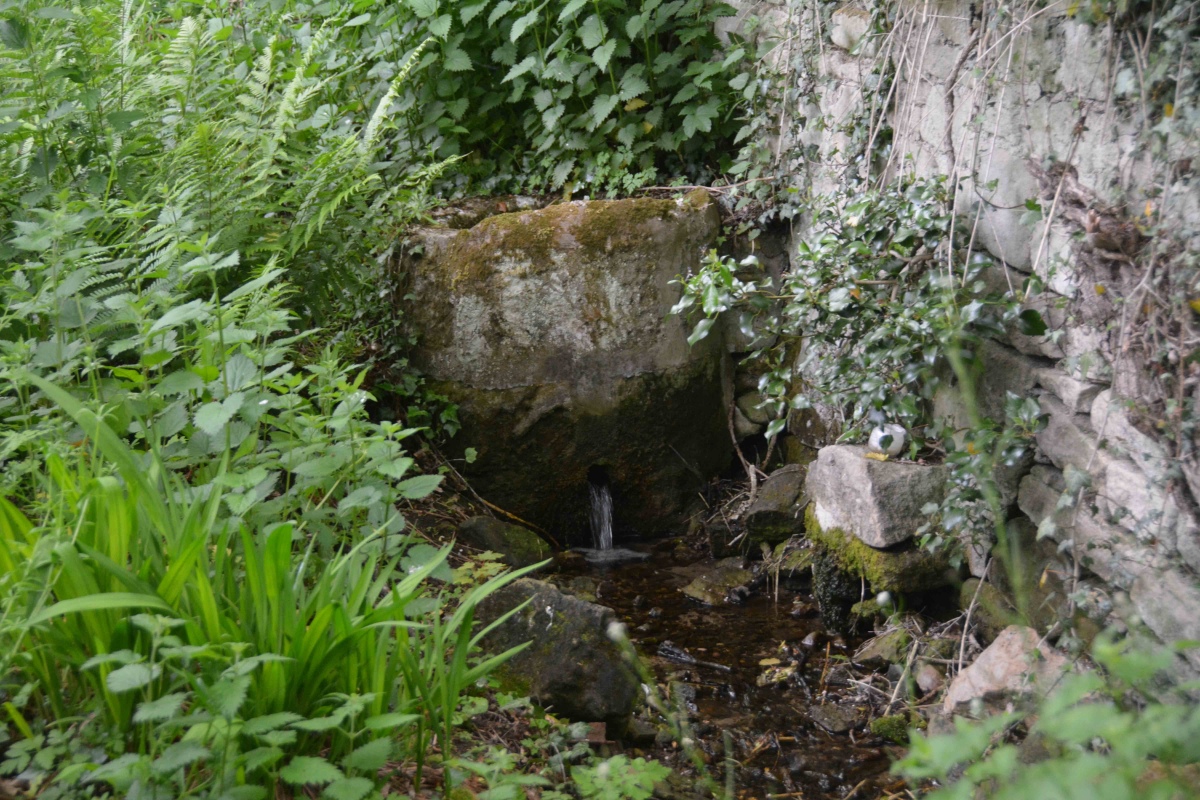
Entry Well (Ovington) submitted by Anne T on 9th Jun 2021. People still visit Entry Well, as there is an overgrown path a few metres to its eastern side. This leads down to the small stream taking water from the well.
(View photo, vote or add a comment)
Log Text: Entry Well, Ovington: A pleasant walk on a warm, sunny Sunday evening, trying to destress before the builders arrive next door tomorrow. Not expecting to find anything at this site, we were surprised by the remaining, and still visible structure here. Not been able to find out anything much about this well, apart from the fact it forms the western boundary of the parish of Ovington. Have appealed for further information until I can get hold of some local history books/journals.
